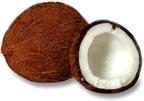If the coconut meat is white and the juice is pretty clear and smells sweet, this is a good coconut. In my area, about half the coconuts are old and bad. They often have mold in them. You will see the mold inside, and it will taste sour. Try to find coconuts that are heavy and have more coconut water in them. Don’t buy any coconuts that have lumps or liquid leaking from the “eyes”.

I try to buy several, to be sure I get a good one. (Take back any bad coconuts you find and complain to the store. The more that people demand fresh coconuts, the sooner we will start getting fresh coconuts in our stores.)
The coconuts that are white on the outside are young coconuts. They have more coconut water and the meat inside is soft enough that you can eat it with a spoon.
Keep your fresh coconut meat and water in the refrigerator or freezer, once opened.
From the book "Coconut Oil Diet Secrets" by Dianne Ronnow, © 2005 Mohave Publishing. All rights reserved.
Lose Weight With Coconut Oil! Thousands of people are losing weight and getting healthier with coconut oil diets. Find out what the secrets of coconut oil dieting are. Check out our site at: Coconut-Oil-Diet.com.



1 comment:
I thought coconuts were bad to eat when on a diet because of the high caloric factor as well as high in cholesteral. At least that is what my nutritionist told me.
Post a Comment